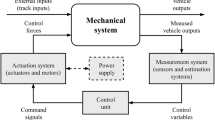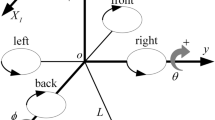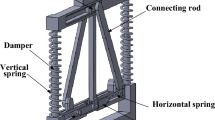Abstract
Purpose
This paper presents a novel disturbance estimation-triggered control solution for the robust tracking problem of active suspensions.
Methods
A disturbance estimation-triggered mechanism based on a nonlinear disturbance observer (NDO) combined with a disturbance effect indicator (DEI) is introduced to reject detrimental disturbances while preserving beneficial disturbances. To simultaneously deal with the exogenous and endogenous uncertainties, an uncertain nonlinear model is adopted in the control design. Unlike previous results, which required a measure of the sprung mass vertical displacement, the proposed strategy requires only the measure of the suspension deflection and facilitates the practical implementation. A linear oscillator with high-static-low-dynamic stiffness is proposed to generate the dynamic reference trajectory.
Results
The proposed active suspension control system is rigorously proven to be input-to-state stable (ISS) by virtue of Lyapunov stability theory. Finally, the proposed controller is used in experimental and numerical environments and compared with classical disturbance-rejection controllers.
Conclusion
Detailed results with various road conditions are provided to demonstrate the improved transient and steady-state tracking performances of the proposed control framework.














Similar content being viewed by others
Code Availability
All the simulation code is based on matlab and simulink.
References
Eski I, Yıldırım S (2009) Vibration control of vehicle active suspension system using a new robust neural network control system. Simul Model Pract Theory 17(5):778–793
Rajendiran S, Lakshmi P (2019) Performance analysis of fractional order terminal SMC for the half car model with random road input. J Vib Eng Technol 8:587–597
Li H, Zhang Z, Yan H, Xie X (2019) Adaptive event-triggered fuzzy control for uncertain active suspension systems. IEEE Trans Cybern 49(12):4388–4397
Pusadkar US, Chaudhari SD, Shendge PD, Phadke SB (2019) Linear disturbance observer based sliding mode control for active suspension systems with non-ideal actuator. J Sound Vib 442:428–444
Pan H, Jing X, Sun W, Gao H (2018) A bio-inspired dynamics-based adaptive tracking control for nonlinear suspension systems. IEEE Trans Control Syst Technol 26(3):903–914
Huang Y, Na J, Wu X, Gao G (2018) Approximation-free control for vehicle active suspensions with hydraulic actuator. IEEE Trans Ind Electron 65(9):7258–7267
Pan H, Jing X, Sun W, Li Z (2018) Analysis and design of a bioinspired vibration sensor system in noisy environment. IEEE/ASME Trans Mechatron 23(2):845–855
Ning D, Sun S, Wei L, Zhang B, Du H, Li W (2017) Vibration reduction of seat suspension using observer based terminal sliding mode control with acceleration data fusion. Mechatronics 44:71–83
Li W, Xie Z, Zhao J, Wong P, Li P (2019) Fuzzy finite-frequency output feedback control for nonlinear active suspension systems with time delay and output constraints. Mech Syst Signal Process 132:315–334
Li H, Jing X, Karimi HR (2014) Output-feedback-based H∞ control for vehicle suspension systems with control delay. IEEE Trans Ind Electron 61(1):436–446
Li P, Lam J, Cheung KC (2014) Multi-objective control for active vehicle suspension with wheelbase preview. J Sound Vib 333(21):5269–5282
Pang H, Wang Y, Zhang X, Xu Z (2019) Robust state-feedback control design for active suspension system with time-varying input delay and wheelbase preview information. J Franklin Inst 356(4):1899–1923
Wang G, Chadli M, Chen H, Zhou Z (2019) Event-triggered control for active vehicle suspension systems with network-induced delays. J Franklin Inst 356(1):147–172
Sun W, Gao H, Kaynak O (2013) Adaptive backstepping control for active suspension systems with hard constraints. IEEE/ASME Trans Mechatron 18(3):1072–1079
Wang Q, Zhao Y, Xu H, Deng Y (2019) Adaptive backstepping control with grey signal predictor for nonlinear active suspension system matching mechanical elastic wheel. Mech Syst Signal Process 131:97–111
Pang H, Zhang X, Yang J, Shang Y (2019) Adaptive backstepping-based control design for uncertain nonlinear active suspension system with input delay. Int J Robust Nonlinear Control 29(16):5781–5800
Pang H, Zhang X, Chen J, Liu K (2019) Design of a coordinated adaptive backstepping tracking control for nonlinear uncertain active suspension system. Appl Math Modell 76:479–494
Deshpande VS, Mohan B, Shendge PD, Phadke SB (2014) Disturbance observer based sliding mode control of active suspension systems. J Sound Vib 333:2281–2296
Ozer HO, Hacioglu Y, Yagiz N (2018) High order sliding mode control with estimation for vehicle active suspensions. Trans Inst Meas Control 40(5):1457–1470
Wang G, Chen C, Yu S (2018) Finite-time sliding mode trackingcontrol for active suspension systemsvia extended super-twisting observer. Proc I Mech Eng I J Syst 231(6):459–470
Pan H, Sun W, Gao H, Jing X (2016) Disturbance observer-based adaptive tracking control with actuator saturation and its application. IEEE Trans Autom Sci Eng 13(2):868–875
Shao X, Naghdy F, Du H, Qin Y (2019) Coupling effect between road excitation and an in-wheel switched reluctance motor on vehicle ride comfort and active suspension control. J Sound Vib 443:683–702
Qin Y, He C, Shao X, Du H, Xiang C, Dong M (2018) Vibration mitigation for in-wheel switched reluctance motor driven electric vehicle with dynamic vibration absorbing structures. J Sound Vib 419:249–267
Pan H, Sun W, Gao H, Hayat T, Alsaadi F (2015) Nonlinear tracking control based on extended state observer for vehicle active suspensions with performance constraints. Mechatronics 30:363–370
Sun W, Zhao Z, Gao H (2013) Saturated adaptive robust control for active suspension systems. IEEE Trans Ind Electron 60(9):3889–3896
Gu C, Yin J, Luo J, Chen X, Wang J (2018) Performance-oriented controls of a novel rocker-pushrod electromagnetic active vehicle suspension. Mech Syst Signal Process 109:1–14
Ding R, Wang R, Meng X, Chen L (2019) Energy consumption sensitivity analysis and energy-reduction control of hybrid electromagnetic active suspension. Mech Syst Signal Process 134:106301
Wang J, Jin F, Zhou L, Li P (2019) Implementation of model-free motion control for active suspension systems. Mech Syst Signal Process 119:589–602
Haddar M, Chaari R, Baslamisli SC, Chaari F, Haddar M (2019) Intelligent PD controller design foractive suspension system based onrobust model-free control strategy. Proc I Mech Eng I J Mech Eng Sci 233(14):4863–4880
Wang HP, Mustafa GIY, Tian Y (2018) Model-free fractional-order sliding mode control for an active vehicle suspension system. Adv Eng Software 115:452–461
Mustafa GIY, Wang HP, Tian Y (2019) Vibration control of an active vehicle suspension systems using optimized model-free fuzzy logic controller based on time delay estimation. Adv Eng Software 127:141–149
Zhang M (2019) Finite-time model-free trajectory tracking control for overhead cranes subject to model uncertainties, parameter variations and external disturbances. Trans Inst Meas Control 41(12):3516–3525
Zhang H, Wei X, Zhang L, Tang M (2017) Disturbance rejection for nonlinear systems with mismatched disturbances based on disturbance observer. J Franklin Inst 354(11):4404–4424
Lee D (2018) Nonlinear disturbance observer-based robust control for spacecraft formation flying. Aerosp Sci Technol 76:82–90
Yang J, Li S, Chen WH (2012) Nonlinear disturbance observer-based control for multi-input multi-output nonlinear systems subject to mismatching condition. Int J Control 85(8):1071–1082
Khamar M, Edrisi M (2018) Designing a backstepping sliding mode controller for an assistant human knee exoskeleton based on nonlinear disturbance observer. Mechatronics 54:121–132
Mohammadi A, Tavakoli M, Marquez HJ, Hashemzadeh F (2013) Nonlinear disturbance observer design for robotic manipulators. Control Eng Pract 21(3):253–267
Guo Z, Guo J, Zhou J (2018) Adaptive attitude tracking control for hypersonic reentry vehicles via sliding mode-based coupling effect-triggered approach. Aerosp Sci Technol 78:228–240
Guo Z, Guo J, Zhou J, Chang J (2020) Robust tracking for hypersonic reentry vehicles via disturbance estimation-triggered control. IEEE Trans Aerosp Electron Syst 56(2):1279–1289
Guo Z, Guo J, Zhou J, Zhao J, Zhao B (2018) Reentry attitude tracking via coupling effect-triggered control subjected to bounded uncertainties. Int J Syst Sci 49(12):2571–2585
Khalil HK (2002) Nonlinear systems, 3rd edn. Prentice Hall, Upper Saddle River
Acknowledgements
The authors would like to thank the editors and the reviewers for their valuable suggestions.
Funding
This work was partly supported by National Natural Science Foundation of China (51605108), Natural Science Foundation of Guangxi Province (2018GXNSFAA281271, 2019JJA160101, GuikeAD18281063), and Science and Technology Major Project of Guangxi Province (AA19046004).
Author information
Authors and Affiliations
Contributions
Gang Wang designed the method and wrote the manuscript, and Hui Jing and Chunyue Huang validated the method and reviewed the manuscript. All authors revised the final manuscript.
Corresponding author
Ethics declarations
Conflict of Interest
No conflict of interest/competing interests exits in the submission of this manuscript, and manuscript is approved by all authors for publication. I would like to declare on behalf of my co-authors that the work described was original research that has not been published previously, and not under consideration for publication elsewhere, in whole or in part. All the authors listed have approved the manuscript that is enclosed.
Additional information
Publisher's Note
Springer Nature remains neutral with regard to jurisdictional claims in published maps and institutional affiliations.
Rights and permissions
About this article
Cite this article
Wang, G., Jing, H. & Huang, C. Nonlinear Disturbance Observer-Based Control for Active Suspension System via Disturbance Estimation-Triggered Approach. J. Vib. Eng. Technol. 9, 1373–1386 (2021). https://doi.org/10.1007/s42417-021-00303-z
Received:
Revised:
Accepted:
Published:
Issue Date:
DOI: https://doi.org/10.1007/s42417-021-00303-z




